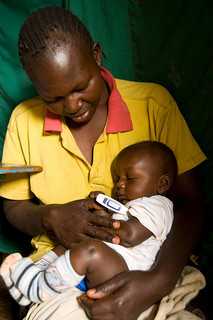Improving Emergency Preparedness & Response
CDC-Kenya strengthens public health capacity to rapidly identify and contain infectious disease threats as well as respond to natural and man-made disasters.
Emergency Preparedness and Response
Effective response to public health emergencies – such as outbreaks of emerging and novel diseases, natural and humanitarian disasters, or large-scale trauma – requires the development of established coordination and communication systems among multiple governmental and non-governmental organizations. CDC-Kenya is working with the Government of Kenya and its partners to improve emergency medical services, coordination of emergency medical response, and processes for improved risk communication to the public and the media.
In this increasingly globalized world, diseases can spread far and wide through international travel and trade. The World Health Organization (WHO) established the International Health Regulations that require countries to report diseases of international concern and outbreaks that may cross international borders. Revised in 2005, these global regulations are intended “to prevent, protect against, control and provide a public health response to the international spread of disease.” CDC-Kenya, alongside WHO, supports the government in its capacity to respond to these requirements by working closely with them to provide technical guidance and support to mobilize resources. Timely and open reporting will help make the world more secure from disease threats.
Outbreak Investigations
CDC-Kenya’s integrated approach to disease detection and response helps reduce the time it takes to identify and control public health risks, helping to stop dangerous outbreaks before they spread. CDC-Kenya works to help the Government of Kenya and other governments in the region detect and respond to serious public health threats, including in refugee camps where outbreaks frequently occur.
CDC-Kenya provides technical assistance to governments in the East Africa region to ensure rapid, coordinated detection and response and promote comprehensive outbreak surveillance. In the case of an outbreak, CDC deploys experts at a host country’s request for technical assistance and diagnostic support. CDC-Kenya often assists with developing case definitions and outbreak control plans, receives specimens for diagnosis confirmation, and provides supplies for response efforts. CDC-Kenya and Field Epidemiology and Laboratory Training Program residents will go into communities, hospitals, refugee camps, and border areas to assist in finding cases, documenting the outbreak, and implementing control strategies and risk communication. For instance, in June, 2011 CDC-Kenya was contacted by the African Union Mission in Somalia (AMISOM) requesting diagnostic support for numerous cases of an acute febrile illness (AFI) occurring among Ugandan and Burundian peacekeeping troops deployed to Mogadishu, Somalia. In September of that same year the Ministry of Public Health and Sanitation (MOPHS) sent samples to Kenya Medical Research Institute/CDC laboratories to test for dengue. Confirmed cases were detected in several areas in Kenya and control measures swiftly implemented.
Ongoing analysis of outbreak responses often leads to the development of research and surveillance projects to predict future outbreaks, measure severe outcomes, and map areas of highest risk. For example, emerging zoonotic diseases (including anthrax, Rift Valley Fever, and brucellosis), which are naturally transmitted between animals and humans, are on the rise – accounting for over 65 percent of emerging infectious diseases. CDC-Kenya and other U.S. government partners have supported the signing of a Memorandum of Understanding between the MOPHS and Ministry of Livestock Development to create an integrated Zoonotic Disease (One Health) Unit. The One Health approach to managing epidemic threats of zoonotic diseases coordinates the work of human, livestock and wildlife, and environmental health experts to better prevent and control these diseases.

A young mother in the Kibera informal settlement in Nairobi is interviewed by a community interviewer as part of ongoing IEIP research by CDC-Kenya. The information gathered from these regular visits helps the CDC to track potential outbreaks of disease in the crowded and unsanitary settlement. © David Synder
- Page last reviewed: November 16, 2012
- Page last updated: November 16, 2012
- Content source:
Global Health
Notice: Linking to a non-federal site does not constitute an endorsement by HHS, CDC or any of its employees of the sponsors or the information and products presented on the site.


 ShareCompartir
ShareCompartir